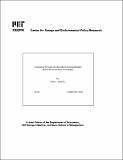Comparing the Costs of Intermittent and Dispatchable Electricity Generating Technologies
Author(s)
Joskow, Paul L.
Download2010-013.pdf (573.4Kb)
Metadata
Show full item recordAbstract
Economic evaluations of alternative electric generating technologies typically rely on comparisons between their expected life-cycle production costs per unit of electricity supplied. The standard life-cycle cost metric utilized is the “levelized cost” per MWh supplied. This paper demonstrates that this metric is inappropriate for comparing intermittent generating technologies like wind and solar with dispatchable generating technologies like nuclear, gas combined cycle, and coal. Levelized cost comparisons are a misleading metric for comparing intermittent and dispatchable generating technologies because they fail to take into account differences in the production profiles of intermittent and dispatchable generating technologies and the associated large variations in the market value of the electricity they supply. Levelized cost comparisons overvalue intermittent generating technologies compared to dispatchable base load generating technologies. They also overvalue wind generating technologies compared to solar generating technologies. Integrating differences in production profiles, the associated variations in the market value of the electricity supplied, and life-cycle costs associated with different generating technologies is necessary to provide meaningful comparisons between them. This market-based framework also has implications for the appropriate design of procurement auctions created to implement renewable energy procurement mandates, the efficient structure of production tax credits for renewable energy, and the evaluation of the additional costs of integrating intermittent generation into electric power networks.
Date issued
2010-09Publisher
MIT Center for Energy and Environmental Policy Research
Other identifiers
2010-013
Series/Report no.
MIT-CEEPR (Series);2010-013